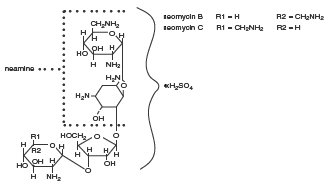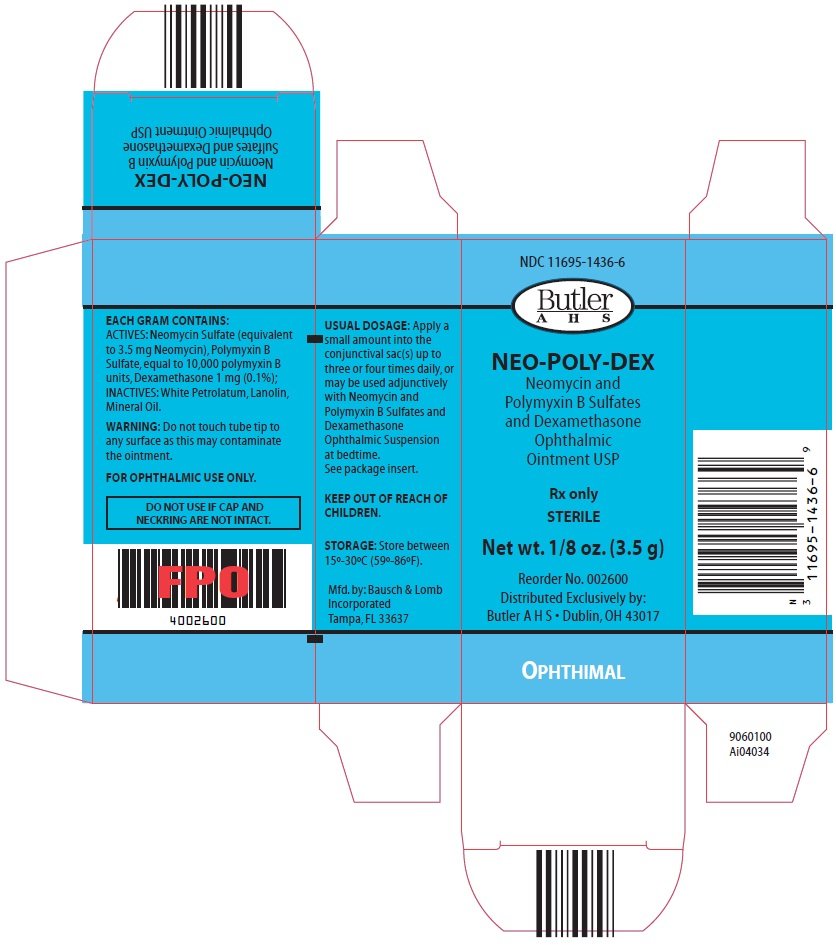Neo-Poly-Dex: Package Insert / Prescribing Info
Package insert / product label
Generic name: neomycin sulfate, polymyxin b sulfate, and dexamethasone
Dosage form: ophthalmic ointment
Drug class: Ophthalmic steroids with anti-infectives
Medically reviewed by Drugs.com. Last updated on Mar 25, 2025.
On This Page
Neo-Poly-Dex Description
Neomycin and Polymyxin B Sulfates and Dexamethasone Ophthalmic Ointment USP is a multiple dose anti-infective steroid combination in a sterile ointment for topical application. The active ingredient dexamethasone, is represented by the following structural formula:

C22H29FO5 Mol. Wt. 392.47
Chemical Name: Pregna-1,4-diene-3,20-dione, 9-fluoro-11,17,21-trihydroxy-16-methyl-, (11β,16α)-.
Neomycin Sulfate is the sulfate salt of neomycin B and C which are produced by the growth of Streptomyces fradiae Waksman (Fam. Streptomycetaceae). It has a potency equivalent to not less than 600 micrograms of neomycin base per milligram, calculated on an anhydrous basis. The structural formulae are:

Polymyxin B Sulfate is the sulfate salt of polymyxin B1 and B2 which are produced by the growth of Bacillus polymyxa (Prazmowski) Migula (Fam. Bacillaceae). It has a potency of not less than 6,000 polymyxin B units per milligram, calculated on an anhydrous basis.
The structural formulae are:

Each Gram Contains: ACTIVES: Neomycin Sulfate (equivalent to 3.5 mg Neomycin), Polymyxin B Sulfate, equal to 10,000 polymyxin B units; Dexamethasone 1 mg (0.1%). INACTIVES: White Petrolatum, Lanolin, Mineral Oil.
PRESERVATIVES ADDED: Methylparaben 0.05%, Propylparaben 0.01%.
Neo-Poly-Dex - Clinical Pharmacology
Corticoids suppress the inflammatory response to a variety of agents and they probably delay or slow the healing. Since corticoids may inhibit the body's defense mechanism against infections, a concomitant antimicrobial drug may be used when this inhibition is considered to be clinically significant in a particular case.
When a decision to administer both a corticoid and an antimicrobial is made, the administration of such drugs in combination has the advantage of greater patient compliance and convenience, with the added assurance that the appropriate dosage of both drugs is administered, plus assured compatibility of ingredients when both types of drugs are in the same formulation and, particularly, that the correct volume of drug is delivered and retained.
The relative potency of corticosteroids depends on the molecular structure, concentration, and release from the vehicle.
Indications and Usage for Neo-Poly-Dex
For steroid-responsive inflammatory ocular conditions for which a corticosteroid is indicated and where bacterial infection or a risk of bacterial ocular infection exists.
Ocular steroids are indicated in inflammatory conditions of the palpebral and bulbar conjunctiva, cornea, and anterior segment of the globe where the inherent risk of steroid use in certain cases of infective conjunctivitides is accepted to obtain a diminution in edema and inflammation. They are also indicated in chronic anterior uveitis and corneal injury from chemical radiation or thermal burns; or penetration of foreign bodies.
The use of a combination drug with an anti-infective component is indicated where the risk of infection is high or where there is an expectation that potentially dangerous numbers of bacteria will be present in the eye.
The particular anti-infective drugs in this product is active against the following common bacterial eye pathogens: Staphylococcus aureus, Escherichia coli, Haemophilus influenzae, Klebsiella/Enterobacter species, Neisseria species, Pseudomonas aeruginosa.
This product does not provide adequate coverage against Serratia marcescens, and Streptococci, including Streptococcus pneumoniae.
Contraindications
Epithelial herpes simplex keratitis (dendritic keratitis), vaccinia, varicella and many other viral diseases of the cornea and conjunctiva. Mycobacterial infection of the eye. Fungal diseases of ocular structures. Hypersensitivity to a component of the medication. (Hypersensitivity to the antibiotic component occurs at a higher rate than for other components.)
Warnings
NOT FOR INJECTION. Do not touch tube tip to any surface, as this may contaminate the contents. Prolonged use may result in glaucoma, with damage to the optic nerve, defects in visual acuity and fields of vision, and posterior subcapsular cataract formation. Prolonged use may suppress the host response and thus increase the hazard of secondary ocular infections. In those diseases causing thinning of the cornea or sclera, perforations have been known to occur with the use of topical steroids. In acute purulent conditions of the eye, steroids may mask infection or enhance existing infection. If these products are used for 10 days or longer, intraocular pressure should be routinely monitored even though it may be difficult in children and uncooperative patients.
Products containing neomycin sulfate may cause cutaneous sensitization.
Employment of steroid medication in the treatment of herpes simplex requires great caution.
Precautions
General
The initial prescription and renewal of the medication order beyond 8 grams should be made by a physician only after examination of the patient with the aid of magnification, such as slit lamp biomicroscopy and, where appropriate, fluorescein staining.
The possibility of persistent fungal infections of the cornea should be considered after prolonged steroid dosing.
Information for Patients:
Do not touch tube tip to any surface, as this may contaminate the contents.
Pregnancy:
Pregnancy Category C. Dexamethasone has been shown to be teratogenic in mice and rabbits following topical ophthalmic application in multiples of the therapeutic dose.
In the mouse, corticosteroids produce fetal resorptions and a specific abnormality, cleft palate. In the rabbit, corticosteroids have produced fetal resorptions and multiple abnormalities involving the head, ears, limbs, palate, etc.
There are no adequate or well-controlled studies in pregnant women. Neomycin, Polymyxin B Sulfates and Dexamethasone Ophthalmic Ointment should be used during pregnancy only if the potential benefit to the mother justifies the potential risk to the embryo or fetus. Infants born of mothers who have received substantial doses of corticosteroids during pregnancy should be observed carefully for signs of hypoadrenalism.
Nursing Mothers:
Systemically administered corticosteroids appear in human milk and could suppress growth, interfere with endogenous corticosteroid production, or cause other untoward effects. It is not known whether topical administration of corticosteroids could result in sufficient systemic absorption to produce detectable quantities in human milk. Because many drugs are excreted in human milk, caution should be exercised when Neomycin, Polymyxin B Sulfates and Dexamethasone Ophthalmic Ointment, is administered to a nursing woman.
Adverse Reactions/Side Effects
Adverse reactions have occurred with steroid/anti-infective combination drugs which can be attributed to the steroid component, the anti-infective component, or the combination. Exact incidence figures are not available since no denominator of treated patients is available.
Reactions occurring most often from the presence of the anti-infective ingredients are allergic sensitizations. The reactions due to the steroid component are: elevation of intraocular pressure (IOP) with possible development of glaucoma, and infrequent optic nerve damage; posterior subcapsular cataract formation; and delayed wound healing.
Secondary Infection: The development of secondary infection has occurred after use of combinations containing steroids and antimicrobials. Fungal infections of the cornea are particularly prone to develop coincidentally with long-term applications of steroids. The possibility of fungal invasion must be considered in any persistent corneal ulceration where steroid treatment has been used.
Secondary bacterial ocular infection following suppression of host responses also occurs.
Related/similar drugs
Neo-Poly-Dex Dosage and Administration
Apply a small amount into the conjunctival sac(s) up to three or four times daily, or may be used adjunctively with Neomycin and Polymyxin B Sulfates and Dexamethasone Ophthalmic Suspension at bedtime.
How to apply Neomycin and Polymyxin B Sulfates and Dexamethasone Ophthalmic Ointment:
1. Tilt your head back.
2. Place a finger on your cheek just under your eye and gently pull down until a "V" pocket is formed between your eyeball and your lower lid.
3. Place a small amount (about 1/2 inch) of Neomycin and Polymyxin B Sulfates and Dexamethasone Ophthalmic Ointment in the "V" pocket. Do not let the tip of the tube touch your eye.
4. Look downward before closing your eye.
Not more than 8 grams should be prescribed initially and the prescription should not be refilled without further evaluation as outlined in PRECAUTIONS above.
| NEO-POLY-DEX
neomycin sulfate, polymyxin b sulfate, and dexamethasone ointment |
||||||||||||||||||||
|
||||||||||||||||||||
|
||||||||||||||||||||
|
||||||||||||||||||||
|
||||||||||||||||||||
|
||||||||||||||||||||
| Labeler - Butler Animal Health Supply (017880659) |
| Registrant - Bausch & Lomb Incorporated (196603781) |
| Establishment | |||
| Name | Address | ID/FEI | Business Operations |
|---|---|---|---|
| Bausch & Lomb Incorporated | 807927397 | MANUFACTURE | |
More about Neo-Poly-Dex (dexamethasone / neomycin / polymyxin b ophthalmic)
- Check interactions
- Compare alternatives
- Reviews (7)
- Side effects
- Dosage information
- During pregnancy
- Drug class: ophthalmic steroids with anti-infectives

